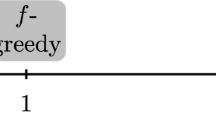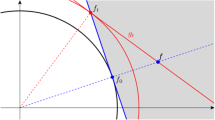Abstract
We propose algorithms to take point sets for kernel-based interpolation of functions in reproducing kernel Hilbert spaces (RKHSs) by convex optimization. We consider the case of kernels with the Mercer expansion and propose an algorithm by deriving a second-order cone programming (SOCP) problem that yields n points at one sitting for a given integer n. In addition, by modifying the SOCP problem slightly, we propose another sequential algorithm that adds an arbitrary number of new points in each step. Numerical experiments show that in several cases the proposed algorithms compete with the P-greedy algorithm, which is known to provide nearly optimal points.




















Similar content being viewed by others
Notes
If K is translation-invariant, we can choose a starting point x1 arbitrarily.
As shown in [3, Proposition 3.3.3], the function \(X \mapsto \log \det X\) is concave on the set of positive definite matrices. Then, the objective function of Problem (3.12) can be regarded as the restriction of this function to the affine subset of the set of positive definite matrices. Therefore, the objective function is log-concave.
The authors of [16] consider the more general case that aj are matrices with a common number of rows.
For example, we observed that Algorithm 1 failed for n = 100 in the case of Example 2 because of this phenomenon.
References
Alizadeh, F., Goldfarb, D.: Second-order cone programming. Math. Program., Ser. B 95, 3–51 (2003)
Atkinson, K., Han, W.: Spherical Harmonics and Approximations on the Unit Sphere: an Introduction. Springer, Berlin (2012)
Borwein, J.M., Lewis, A.S.: Convex Analysis and Nonlinear Optimization: Theory and Examples, 2nd edn. Springer, New York (2006)
Briani, M., Sommariva, A., Vianello, M.: Computing Fekete and Lebesgue points: simplex, square, disk. J. Comput. Appl. Math. 236, 2477–2486 (2012)
Buhmann, M.: Radial basis functions. Acta Numer. 10, 1–38 (2000)
Dai, F., Xu, Y.: Approximation Theory and Harmonic Analysis on Spheres and Balls. Springer, New York (2013)
Fasshauer, G.: Meshfree Approximation Methods with MATLAB. World Scientific, Singapore (2007)
Fasshauer, G., McCourt, M.: Kernel-Based Approximation Methods Using MATLAB. World Scientific, Singapore (2015)
Lobo, M.S., Vandenberghe, L., Boyd, S., Lebret, H.: Applications of second-order cone programming. Linear Algebra Appl. 284, 193–228 (1998)
De Marchi, S.: On optimal center locations for radial basis function interpolation: computational aspects. Rend. Sem. Mat. Univ. Pol. Torino 61, 343–358 (2003)
De Marchi, S.: Geometric greedy and greedy points for RBF interpolation. In: Proceedings of the International Conference on Computational and Mathematical Methods in Science and Engineering, CMMSE 2009 (2009)
De Marchi, S., Schaback, R., Wendland, H.: Near-optimal data-independent point locations for radial basis function interpolation. Adv. Comput. Math. 23, 317–330 (2005)
Nguyen, V.P., Rabczuk, T., Bordas, S., Duflot, M.: Meshless methods: a review and computer implementation aspects. Math. Comput. Simul. 79, 763–813 (2008)
Müller, S.: Complexity and stability of kernel-based reconstructions (in German). dissertation, Georg-August-Universität Göttingen, Institut für Numerische und Angewandte Mathematik, Lotzestrasse 16-18, D-37083 Göttingen, Jan 2009. Göttinger Online Klassifikation: EDDF 050 (2009)
Sangol, G.: Computing optimal designs of multiresponse experiments reduces to second order cone programming. J. Statist. Plann. Inference 141, 1684–1708 (2011)
Sangol, G., Harman, R.: Computing exact D-optimal designs by mixed integer second-order cone programming. Ann. Statist. 43, 2198–2224 (2015)
Santin, G., Haasdonk, B.: Convergence rate of the data-independent P-greedy algorithm in kernel-based approximation. Dolomites Research Notes on Approximation 10, 68–78 (2017)
Schaback, R., Wendland, H.: Adaptive greedy techniques for approximate solution of large RBF systems. Numer. Algor. 24, 239–254 (2000)
Schaback, R., Wendland, H.: Kernel techniques: from machine learning to meshless methods. Acta Numer. 15, 543–639 (2006)
Tanaka, K.: Matlab programs for generating point sets for interpolation in reproducing kernel Hilbert spaces. https://github.com/KeTanakaN/mat_points_interp_rkhs (last accessed on October 19, 2018)
Wendland, H.: Scattered Data Approximation. Cambridge University Press, Cambridge (2005)
Acknowledgments
The author thanks Takanori Maehara for his valuable comment about the MATLAB programs used in the numerical experiments. Thanks to the comment, much faster execution of the proposed algorithms has been realized than that in the initially submitted version of this article. Furthermore, the author gives thanks to the anonymous reviewers for their valuable suggestions about this article.
Funding
The author is supported by the grant-in-aid of Japan Society of the Promotion of Science with KAKENHI Grant Number 17K14241.
Author information
Authors and Affiliations
Corresponding author
Additional information
Publisher’s note
Springer Nature remains neutral with regard to jurisdictional claims in published maps and institutional affiliations.
Appendix. Remarks on implementation of SOCP (4.6) by MOSEK
Appendix. Remarks on implementation of SOCP (4.6) by MOSEK
1.1 MOSEK
As a software to solve SOCP problems, we use the MOSEK Optimization Toolbox for MATLAB 8.1.0.56, which is provided by MOSEK ApS in Denmark (https://www.mosek.com/, last accessed on 19 October 2018).
1.1.1 Expression of rotated second-order cones
Recall that \(p = \lceil \log _{2} \ell \rceil \). In SOCP (4.6) in which ℓ is even, we need to consider the rotated second-order cone constraints
Furthermore, in the counterpart in which ℓ is odd, we need to consider the constraints
However, MOSEK permits only the expression \({\eta _{1}^{2}} + {\cdots } + {\eta _{N}^{2}} \leq 2 \xi \zeta \) for a rotated second-order cone, where we just need the case that N = 1. Therefore, we employ the following variable transformations:
We do not change ui because of the following reason. If we change the constraints \({u_{i}^{2}} \leq u_{2i} u_{2i+1}\) to \({u_{i}^{2}} \leq 2 u_{2i} u_{2i+1}\), they just change the optimal value by \(2^{(p-1)2^{p-1}}\) times.Footnote 5 Consequently, we deal with the SOCP problem

in the case that ℓ is even, and

in the case that ℓ is odd.
1.1.2 Restriction about cone constraints
MOSEK does not permit that a variable belongs to plural cones. However, we need to consider the cone constraints in (5.16) and (5.17) in which each ui appears 2 times and each \(\hat {w}_{i}\) appears ℓ times. Therefore, we prepare the copies of these variables:
and set the linear constraints between these variables:
Then, we introduce a vector
1.2 Linear constraints
To describe the linear constraints in (5.16) and (5.17) in terms of the vector v, we provide a matrix A and vectors bl and bu that express the constraints as bl ≤ Av ≤ bu.
We begin with the case that ℓ is even. First, we express the constraints in (5.18) and (5.19) by
and
respectively. Next, we consider the constraint
By using v and the expression
we express the linear constraint as follows:

Next, we express the constraint \(\hat {w}_{1\ell } + {\cdots } + \hat {w}_{m\ell } = n/2\) by
Next, we express the inequality constraints
by

Finally, we consider the constraints
which are equivalent to the linear constraints ui ≤ u1 owing to the non-negative constraints ui ≥ 0. These constraints are expressed by

Consequently, by setting
we can express the linear constraints as bl ≤ Av ≤ bu.
In the case that ℓ is odd, we need to modify A3, A5, A6, bl, and bu. We replace the component “\(-~\sqrt {2}\)” in the last rows of A3 and A5 by “− 2”. Furthermore, we modify A6, bl, and bu as

respectively.
1.3 Constraints for the ranges of the variables
Besides the constraints ui ≥ 0 and \(0 \leq \hat {w}_{j} \leq 1/2\) in (5.16) and (5.17), we can add \(\hat {g}_{i} \geq 0\) and tij ≥ 0 because any solution that does not satisfy these constraints is useless. Therefore, by using the vectors given by
we can express the constraints for the ranges of the variables as \(\tilde {b}_{\mathrm {l}} \leq v \leq \tilde {b}_{\mathrm {u}}\).
1.4 Cone constraints
To express the cone constraints in (5.16) and (5.17) by MOSEK, we need to specify the components of the vector v that correspond to the constraints. For the constraints
we take the components v2i, v2(2i)− 1, and v2(2i+ 1)− 1 for ui, u2i, and u2i+ 1, respectively. For the constraints
we take the components v2i, \(v_{2^{p} + 2i - 1}\), and \(v_{2^{p} + 2i}\) for ui, \(\hat {g}_{2i - 2^{p} + 1}\), and \(\hat {g}_{2i - 2^{p} + 2}\), respectively. In the case that ℓ is odd, we take the components \(v_{2^{p} + \ell - 1}\), \(v_{2(2^{p} -1) + \ell }\), and v1 for the constraint \(u_{2^{p-1} + (\ell -1)/2}^{2} \leq 2 \hat {g}_{\ell } u_{1}\). Finally, for the constraints
we take the components \(v_{2(2^{p}-1) + \ell + ij}\), \(v_{2(2^{p}-1) + \ell + ij + m\ell }\), and \(v_{2(2^{p}-1) + \ell + ij + 2m\ell }\).
Rights and permissions
About this article
Cite this article
Tanaka, K. Generation of point sets by convex optimization for interpolation in reproducing kernel Hilbert spaces. Numer Algor 84, 1049–1079 (2020). https://doi.org/10.1007/s11075-019-00792-w
Received:
Accepted:
Published:
Issue Date:
DOI: https://doi.org/10.1007/s11075-019-00792-w
Keywords
- Reproducing kernel Hilbert space
- Kernel interpolation
- Point set
- Power function
- Optimal design
- Second-order cone programming




